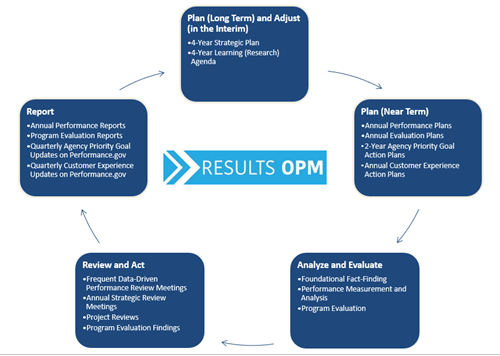Results OPM: OPM’s Performance Management Approach
OPM is committed to building a strong performance culture through effective performance management processes that promote using data to make decisions and measure progress toward specific goals. OPM’s performance management cycle is depicted below.
- Plan (Long Term) and Adjust (in the Interim): Every four years, OPM develops a Strategic Plan, which presents the agency’s long-term strategic goals. Alongside the Strategic Plan, OPM develops a Learning Agenda that identifies the agency’s priority research questions.
- Plan (Near Term): As part of the annual budgeting process, OPM develops Annual Performance Plans and Annual Evaluation Plans. Annual Performance Plans reflect the full scope of the Strategic Plan and describe the level of performance to be achieved in the current and next fiscal year. Annual Evaluation Plans identify the specific evaluations the agency will carry out in a year. Based on the top priorities of the agency and Administration, OPM also develops two-year Agency Priority Goals and action plans that are aligned to the Strategic Plan. Further, OPM develops annual customer experience action plans for its two High Impact Service Providers: Retirement Services and USAJOBS.
- Analyze and Evaluate: To better understand agency performance, OPM carries out performance measurement as outlined in its Annual Performance Plan, Agency Priority Goal Action Plans, and Customer Experience Action Plans, and other analysis, research, and evaluation activities as outlined in its Learning Agenda and Annual Evaluation Plan.
- Review and Act: OPM conducts frequent data-driven performance review (or Results OPM) meetings, chaired by the Chief Management Officer, to drive progress toward the strategic goals and objectives outlined in the Strategic Plan. Agency leaders diagnose problems and opportunities, learn from past experiences, and decide next steps to improve performance. OPM also carries out an annual strategic review to assess agency progress and determine which strategic objectives require focused improvement relative to other strategic objectives.
- Report: Every year, OPM publishes this Annual Performance Report which outlines the agency’s progress toward the strategic goals and objectives in the agency’s Strategic Plan and includes key findings from agency program evaluations and progress on the agency’s two-year Agency Priority Goals. On a quarterly basis, the agency also publicly reports on progress toward Agency Priority Goals and on customer experience.



